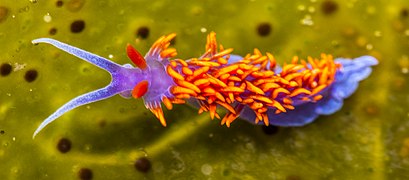| Spanish shawl Flabellinopsis iodinea | |
|---|---|
 | |
| Scientific classification | |
| Domain: | Eukaryota |
| Kingdom: | Animalia |
| Phylum: | Mollusca |
| Class: | Gastropoda |
| Order: | Nudibranchia |
| Suborder: | Cladobranchia |
| Family: | Flabellinopsidae |
| Genus: | Flabellinopsis |
| Species: | F. iodinea |
| Binomial name | |
| Flabellinopsis iodinea (Cooper, 1863) | |
| Synonyms | |
| |
Flabellinopsis iodinea, the Spanish shawl, is a species of aeolid nudibranch, a very colorful sea slug. This is a marine gastropod mollusk in the family Flabellinidae.




